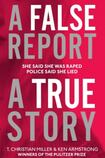
Rape. It’s a word nobody ever wants to claim for their own experience. Everyone knows what the horror of that word means. But there is something even worse than that, which this book explores, which is being raped and not being believed by the authorities when report the crime.
A False Report, by journalists T Christian Miller and Ken Armstrong, is a true crime book about a serial rapist. Marc O'Leary, a former member of the military, was stalking women in Washington State and Colorado from at least 2008 to 2011, when he was finally caught. His modus operandi is the stuff of urban nightmares: he drove around neighbourhoods, searching for women who lived alone, in poorly-lit ground floor apartments with fragile sliding doors. He sometimes observed them for weeks before breaking in at night with his "rape kit" to savagely assault them for hours. He took pictures. Afterwards, he made them shower to destroy DNA evidence. He took their bedlinen with him.
Miller and Armstrong unpick the timeline of the stomach-churning story of O’Leary’s sexual deviance. They examine how two exceptional detectives, Edna Hendershot and Stacy Galbraith, each based in different districts, shared their information of their separate investigations to find him. His victims were teenagers, and women aged 59 and 65. One of the reasons it took so long to catch O’Leary is that one of his early victims – an essential missed link to the other cases – was deemed to be lying by police when she gave her statement.
Retracted statement
Marie was a vulnerable 18-year-old in supported housing, who had just come out of foster care. She was in trauma, and overwhelmed by having to tell her story of being raped over and over again without sleep. Her own foster mother called the police and said she had suspicions that Marie was just looking for attention by coming to them with this story. Under duress, Marie retracted her statement. The evidence taken from her apartment was destroyed. By the time she had regained the courage to insist that she had been sexually assaulted for hours, the police refused to believe her.
This book started out as a 12,000 word story by Miller and Armstrong for Pro Publica, an American non-profit investigative journalism organisation, for which it won a Pulitzer in 2016. It’s now been optioned by Netflix for a drama series, which is an indicator of how popular it is expected to be.
Flat style
There's a significant difference between a longform article and a book-length text. A False Report starts strongly, with compelling narrative, but it falls apart about halfway. The authors have used the book length format to develop key topics of the story: the fallout from rape; victim blaming; social media shaming; the behaviour of sexual predators; the question of truth; the way the American police and other authorities generally treat women who report rape.
The problem is, the polemic interrupts the narrative of the women involved in this particular story. The book is trying to be both a true-crime story and a public service piece of reporting: the reporters just couldn’t stop being reporters, instead of focusing solely on being writers.
The other problem is that authors have combined their reporting, and the result is a curiously flat style overall, without any distinctive voice. There are few subjects more intimate than rape, but the perspective of the narrative often feels distant. The authors write about all their subjects in the third person, and sometimes it feels like reading a translated transcript.
In all this, however, there are some details in Miller and Armstrong’s reporting that genuinely scandalise. Marie, who was vilified, bullied and shamed both in the mainstream media and social media during the period of time she retracted her story of being raped, eventually sued the authorities for the way they had mishandled her case. She sued for millions. She received $150,000.
On paper, A False Report has all elements of being a really powerful story, but it ultimately fails to truly engage. The irony is, it'll make a terrific Netflix drama.











